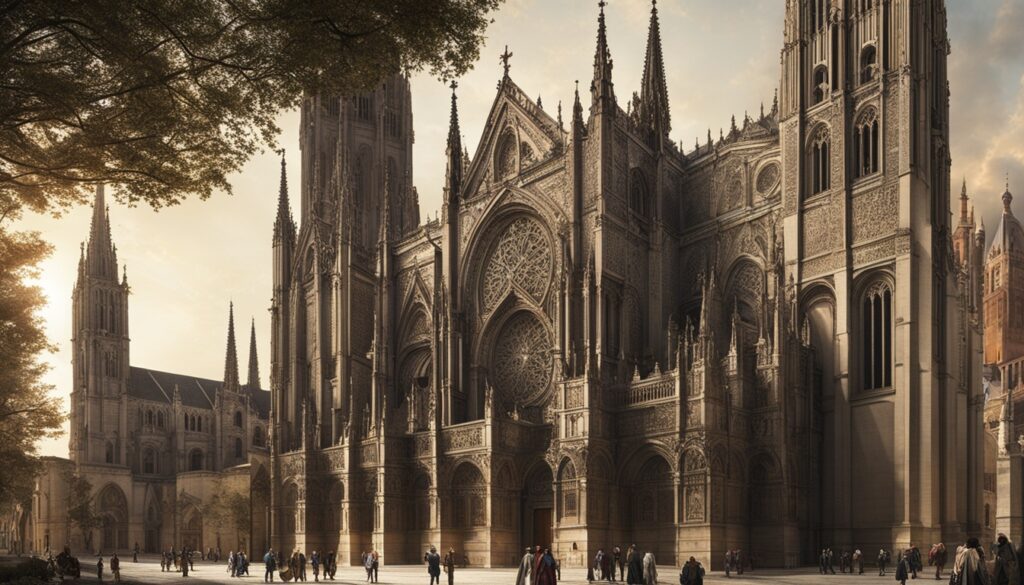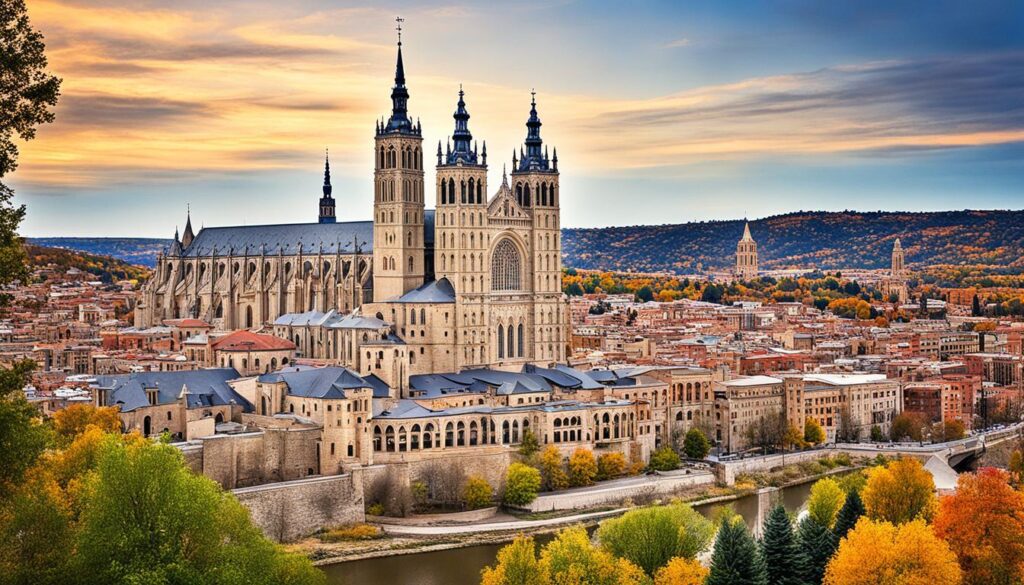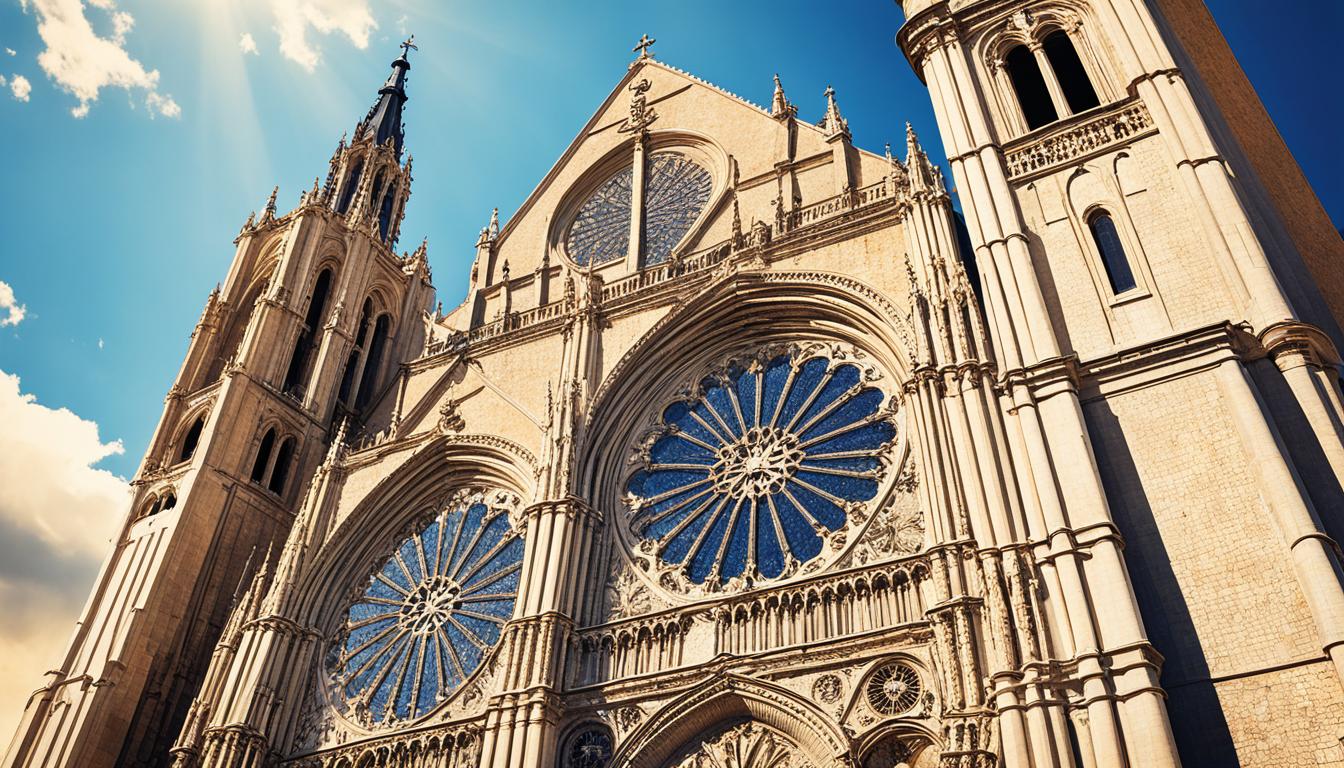The Toledo Cathedral, also known as the Primatial Cathedral of Saint Mary of Toledo, stands tall in the historic city of Toledo. It’s a stunning example of Gothic architecture. This Roman Catholic church has been amazing visitors for centuries with its design and cultural history.
It took 267 years, from 1226 to 1493, to build this Gothic masterpiece. The design was inspired by French Gothic but also includes Mudéjar elements. This mix makes it one of Europe’s greatest Gothic buildings.
The cathedral’s size is impressive, measuring 120 meters long, 59 meters wide, and with a nave 18 meters wide. Its height reaches 44.5 meters, making it a dominant feature in the city’s skyline.
Key Takeaways
- The Toledo Spain Cathedral is a stunning example of Gothic architecture, blending French Gothic and Mudéjar styles.
- Construction on the cathedral began in 1226 and was completed in 1493, taking a total of 267 years to build.
- The cathedral’s impressive dimensions, including a length of 120 meters and a height of 44.5 meters, make it a truly imposing structure.
- The Toledo Cathedral is ranked among the top 10 cathedrals in Spain and is considered one of the greatest Gothic structures in Europe.
- The cathedral houses an array of artistic masterpieces, including works by renowned artists such as El Greco, Velázquez, and Goya.
Introduction to Toledo Cathedral
Toledo Cathedral stands tall in the heart of Toledo, Spain. It’s among the top 10 cathedrals in the country and a true architectural marvel. Its beauty and lasting impact have made it a cultural treasure for many years.
Architectural Marvel and Cultural Treasure
The cathedral’s inside is huge, showing off classic Gothic style. You’ll see tall rose windows, flying buttresses, and ribbed vaults. Its size and design were groundbreaking in the Iberian Peninsula before the 14th century.
This makes it one of the most important Gothic sites in Europe and the Mediterranean during the 13th and 14th centuries.
Historical Significance and Enduring Legacy
The cathedral has a rich history, dating back to the Visigothic era. Under Muslim rule, it was the site of the city’s main mosque. After 1085, it became a church and was later rebuilt into the Gothic structure we see today.
This cathedral’s history and lasting impact have made it a cherished landmark for centuries.
The cathedral started in 1226 during the reign of Ferdinand III and Archbishop Rodrigo Ximénez de Rada. It took 200 years to finish, with the last details added in 1493.
Construction Phases of the Cathedral
The Toledo Cathedral is a Gothic masterpiece that took nearly three centuries to build. It started in the 13th century and finished in the late 15th century. This cathedral shows how Gothic styles changed over time. It also highlights the hard work of the architects and craftsmen who made it.
Early Gothic Phase (1226-1300)
The cathedral started in 1226. During this early Gothic phase, the foundation and main parts like the nave, transepts, and aisles were built. By 1300, the central nave was finished, which was a big step in the cathedral’s growth.
High Gothic Phase (1300-1400)
In the 14th century, the cathedral got even more beautiful. The Santiago Chapel, the cloister, and the chapter house were built. This phase made the cathedral even more stunning and a true Gothic masterpiece.
Late Gothic Phase (1400-1493)
The last phase, in the 15th century, focused on the cathedral’s outside. This included the west facade, the bell tower, and the spires. After many years, the Toledo Cathedral was consecrated in 1493. This showed the dedication of those who built it.
The construction faced big challenges, like the Black Death pandemic. But the architects and builders didn’t give up. They finished the early gothic phase, high gothic phase, and late gothic phase of the toledo cathedral construction. This gave us this amazing Gothic masterpiece.
| Construction Phase | Timeline | Key Achievements |
|---|---|---|
| Early Gothic Phase | 1226-1300 | Laying of the foundation, construction of the nave, transepts, and aisles |
| High Gothic Phase | 1300-1400 | Building of the Santiago Chapel, cloister, and chapter house |
| Late Gothic Phase | 1400-1493 | Completion of the west facade, bell tower, and spires; official consecration in 1493 |
“The Toledo Cathedral is a true testament to the enduring power of human ingenuity and creativity. Its construction, spanning nearly three centuries, is a remarkable feat that has left an indelible mark on the architectural landscape of Spain.”
Architectural Styles and Significance
The Toledo Cathedral is a mix of architectural styles, showing Spain’s rich heritage. It mainly follows Gothic design, with features like pointed arches and large windows. These let in lots of natural light.
The cathedral’s look, with flying buttresses and detailed sculptures, shows French Gothic style’s impact. This style came to Spain in the 13th century.
The cathedral also has Mudéjar style, blending Islamic and Christian designs. This is seen in the cloister and triforium, with their complex patterns. The mix of Gothic and Mudéjar styles makes the Toledo Cathedral stand out in Europe.
| Architectural Significance | Key Highlights |
|---|---|
| Architectural Innovation | The toledo cathedral architectural styles were a big change from local building ways. They showed a new scale and boldness in design. |
| European Influence | The cathedral’s gothic architecture and its rich treasury show its importance in Europe and the Mediterranean in the 13th and 14th centuries. |
| Mudéjar Integration | The mudéjar style fits well with the Gothic design, making the cathedral’s architecture unique and culturally important. |
The Toledo Cathedral’s mix of Gothic and Mudéjar styles shows the cultural exchange and innovation of medieval Spain. This blend of styles has made the cathedral a Spanish gothic architecture masterpiece. It’s a cultural treasure that draws visitors from all over the world.
Dimensions and Features
The Toledo Cathedral, also known as the Catedral Primada, is a stunning example of architecture. It captures the hearts of visitors with its large size and detailed design. This iconic site is among the top 10 cathedrals in Spain and is a UNESCO World Heritage Site.
The cathedral’s size is impressive: 120 meters long, 59 meters wide, and 44.5 meters tall. The main nave reaches up to 30.5 meters high. The bell tower stands at an amazing 92 meters, making it a key part of the city’s view.
The design of the cathedral shows the growth of Gothic architecture. It features flying buttresses, ribbed vaults, and pointed arches. Made from white limestone, it’s a prime example of High Gothic architecture, known for its unique details.
| Cathedral Feature | Measurement |
|---|---|
| Length | 120 meters (394 feet) |
| Width | 59 meters (194 feet) |
| Height | 44.5 meters (146 feet) |
| Central Nave Height | 30.5 meters (100 feet) |
| Bell Tower Height | 92 meters (302 feet) |
| Number of Chapels | 27 |
When you visit, you’ll be amazed by the stunning altar, the beautiful choir, and the nine chapels behind the main altar. Don’t miss El Transparente, a special feature that looks like a cave in the dome.
If you love architecture or want to learn about Spain’s history and culture, the Toledo Cathedral is a place you must see. It offers a peek into Spain’s artistic and spiritual heritage.
Artworks and their Importance
The Toledo Cathedral is home to a stunning collection of artworks. These include paintings by famous Spanish artists like El Greco, Diego Velázquez, and Francisco Goya. Their works highlight the artists’ skill and creativity. They also add to the cathedral’s cultural value.
El Greco’s Masterpieces
El Greco, a Greek artist who lived in Toledo, made many beautiful works for the cathedral. His famous pieces include “The Disrobing of Christ” (1577-1579) and “The Burial of the Count of Orgaz” (1586-1588). These paintings are top examples of Spanish Renaissance art. They show El Greco’s unique style and deep spirituality.
Velázquez’s Contributions
Diego Velázquez, a top artist of the Spanish Golden Age, also worked on the cathedral. His painting “The Crowning of the Virgin” (1635-1636) is in the sacristy. It shows Velázquez’s skill in composition, light, and color. This painting proves he was one of Spain’s greatest painters.
Goya’s Frescoes
Francisco Goya, a key Spanish artist from the late 18th and early 19th centuries, painted frescoes for the cathedral’s cloisters. These are known as the “Pinturas negras” (Black Paintings). They reflect Goya’s darker view of human nature, adding depth to the cathedral’s art.
The cathedral also has a collection of medieval and Renaissance sculptures. This includes the choir stalls and the main chapel’s altarpiece. These pieces show the talent of Spanish artists and craftsmen. With its amazing architecture and art, the Toledo Cathedral is a gem for art lovers and history fans.
Historical Timeline and Events
The Toledo Cathedral has seen a lot of history, playing a big part in the city’s growth. It has been the site of coronations and the creation of art. This Gothic building has been a key part of Toledo’s story.
In 1085, King Alfonso VI of León and Castile was crowned here, a big moment for Toledo. The cathedral started in 1226 under Archbishop Don Rodrigo Jiménez. It has grown in beauty over the years.
In 1469, the cathedral was where King Ferdinand II of Aragon and Queen Isabella I of Castile got married. This united the kingdoms and started the Spanish Empire. The cathedral was officially blessed in 1493, a big step in its history.
Many famous artists have worked here, like El Greco, who started “The Disrobing of Christ” in 1577. Diego Velázquez added to its beauty with “The Crowning of the Virgin” in 1635.
The cathedral has faced hard times too, like the French occupation in 1808 and damage in the Spanish Civil War in 1936. But it has always stood strong. It was named a UNESCO World Heritage Site in 1986.
Today, the cathedral is a key part of Toledo’s culture and architecture. It attracts millions of visitors each year. They come to see its beauty and learn about its history.
| Historical Event | Year |
|---|---|
| Coronation of King Alfonso VI of León and Castile | 1085 |
| Beginning of cathedral construction | 1226 |
| Marriage of King Ferdinand II and Queen Isabella I | 1469 |
| Official consecration of the cathedral | 1493 |
| El Greco begins “The Disrobing of Christ” | 1577 |
| Velázquez paints “The Crowning of the Virgin” | 1635 |
| French troops occupy Toledo during Peninsular War | 1808 |
| Cathedral suffers damage during Spanish Civil War | 1936 |
| Toledo Cathedral declared UNESCO World Heritage Site | 1986 |
The Toledo Cathedral’s timeline shows its lasting importance in the city’s history. It has seen coronations and art creations. This Gothic treasure is a symbol of Toledo’s strength and culture.

toledo spain cathedral
The Toledo Cathedral in Spain is a stunning example of Gothic architecture. It’s a Roman Catholic cathedral and the main church in Toledo. It’s known for its Gothic beauty and is a key spot in Spain.
Work on the Toledo Cathedral started in 1226 under King Ferdinand III. It finished in 1493, during the Catholic Monarchs’ rule. The design mixes French Gothic with Mudéjar styles, showing the mix of Islamic and Christian cultures in Spain.
The inside of the cathedral is amazing, with Gothic features like ribbed vaults and big windows. It’s filled with light. You can see artworks by famous Spanish artists like El Greco, Diego Velázquez, and Francisco Goya.
“The Toledo Cathedral is a testament to the remarkable blending of architectural styles that defined Spain’s rich cultural heritage.”
Visiting the Toledo Cathedral lets you see its history and beauty. Tickets cost €12.00 for adults, with discounts for kids, seniors, and students. It’s open Monday to Saturday from 10am to 6:30pm and on Sundays from 2:30pm to 6:30pm.
Toledo has more than just the cathedral. You can see events like Holy Week and the Feast of the Virgen del Sagrario. You can also buy souvenirs like marzipan and traditional swords. The Toledo Cathedral is a key spot for anyone visiting Spain.
Role in Toledo’s Cultural Development
The Toledo Cathedral has been key in shaping Toledo, Spain’s culture. It’s a center of learning and artistic exchange. The cathedral has a vast library with over 3,000 manuscripts and 75,000 books. These cover theology, philosophy, science, and history.
The cathedral’s building and skilled workers from Europe boosted Toledo’s artistic and commercial sectors. Now, it’s a top tourist attraction, bringing in millions yearly. In 2019, it welcomed nearly 2 million visitors, showing its big cultural and economic impact on Toledo.
Center of Learning and Artistic Exchange
- The Toledo Cathedral’s Biblioteca Capitular has over 3,000 manuscripts and 75,000 printed books, covering many subjects.
- It’s been a place for scholars and artists from across Europe to meet and share ideas.
- Works by famous artists like El Greco, Velázquez, and Goya make it a cultural gem.
Economic Impact and Tourism
The cathedral’s fame as a tourist spot has a big economic impact on the city. In 2019, it drew nearly 2 million visitors. This has helped local businesses, from hotels to shops, grow.

“Toledo has remained a vital center of culture, art, and religion despite being small in population and of minor political importance.”
Conclusion
The Toledo Cathedral is a key part of Spain’s rich architectural heritage. It shows off a mix of Gothic and Mudéjar styles. The cathedral is known for its art and its big role in Toledo’s history.
Its long building process and big impact on Toledo tell us a lot about medieval and early modern Spain. Artists like El Greco, Diego Velázquez, and Francisco Goya added to its artistic value. Their work shows the cathedral’s importance in Spanish art history.
The Toledo Cathedral reminds us of the need to keep our architectural past alive. Its story is about overcoming challenges, being innovative, and sharing cultures. It reflects the complex history of Spain. By learning from and valuing this cathedral, we understand Spain’s cultural story better. It inspires us to keep up the tradition of creativity and faith it symbolizes.

